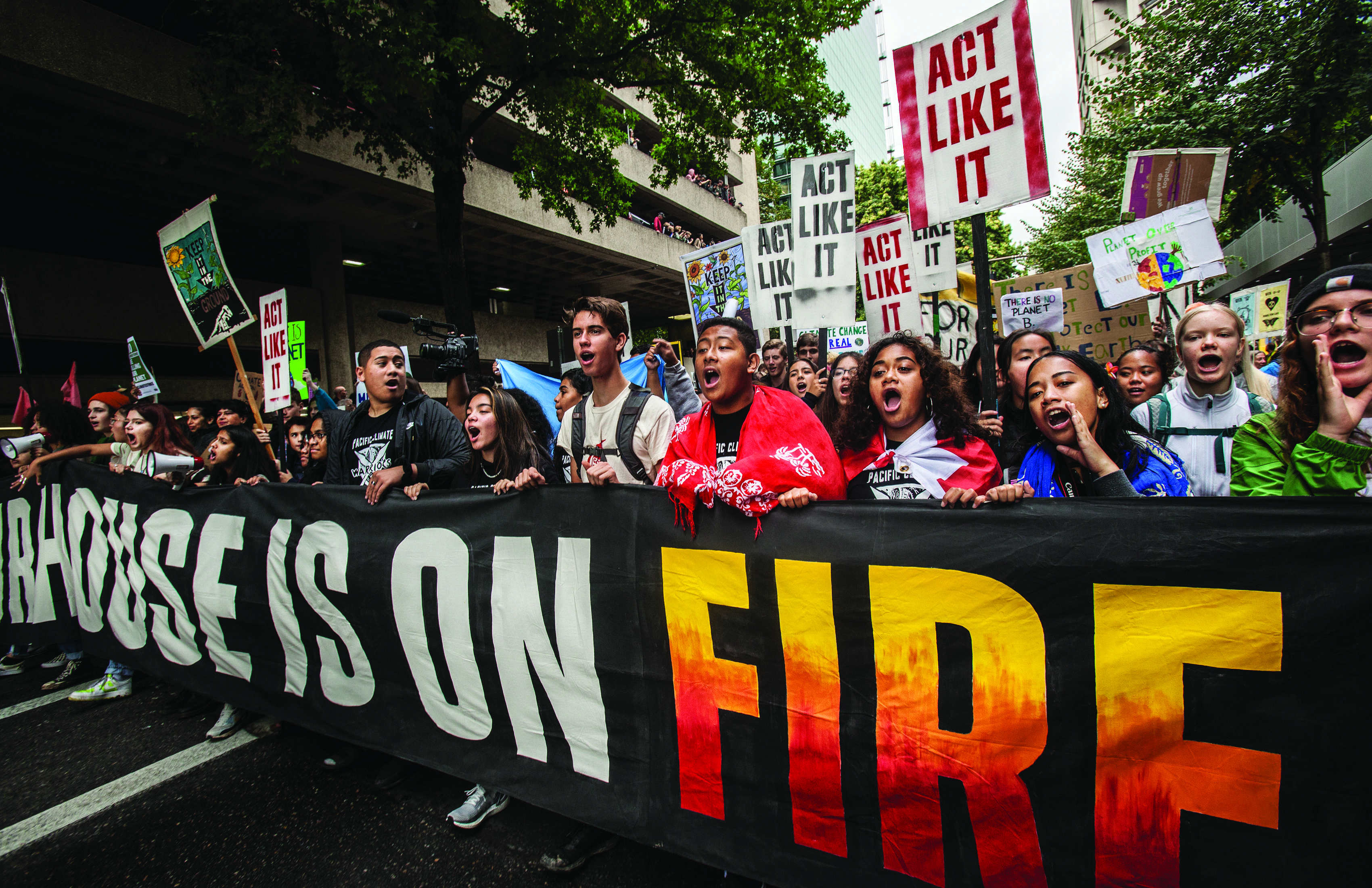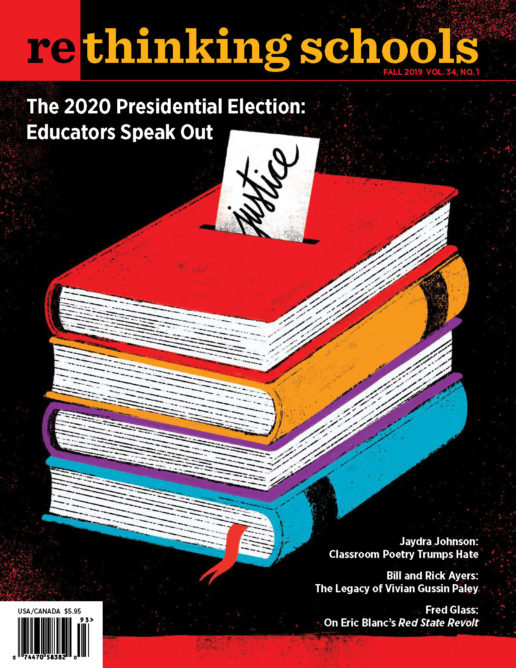Teach the Fossil Fuel Industry — Our Students’ Enemy
Column: Earth, Justice, and Our Classrooms
Illustrator: Rick Rappaport

A while back, I was invited to lead a workshop on teaching the climate crisis at a teacher education program at a Portland, Oregon-area college. I chose an activity I wrote called “The Mystery of the Three Scary Numbers” — included in the Rethinking Schools book A People’s Curriculum for the Earth and at the Zinn Education Project’s Teach Climate Justice site. It’s based on a famous Bill McKibben article in Rolling Stone, “Global Warming’s Terrifying New Math.” The terrifying math that McKibben lays out is simple: In order to keep the climate from warming more than two degrees Celsius over pre-industrial temperatures, the world’s “carbon budget” is 565 gigatons — carbon of all sources that, collectively, the world can emit and have a reasonable hope of staying under two degrees. The terrifying number is how much carbon is stored in the known reserves of fossil fuel companies and countries that act like fossil fuel companies, like Saudi Arabia: 2,795 gigatons — five times the amount of the world’s carbon budget. Yes, I know, there are lots of problems with this formulation. For example, two degrees is a horribly inadequate target, one that will condemn much of the world to climate catastrophe. And the 2,795 number grows every day, as profit-driven fossil fuel companies — and the governments they purchase — drill and dig and scrape the Earth for still more fossil fuels. But the core lesson remains: We cannot burn a substantial portion of known fossil fuel reserves and hope to survive.
In the activity, students receive short clues on strips of paper about different aspects of the three scary numbers — 565 gigatons, 2,795 gigatons, 2 degrees Celsius — and circulate in the classroom, finding people with other clues that connect with theirs. Following the activity, students write on the three numbers, what makes them scary, and the implications: What should we do?
The future teachers had lots of thoughts on this, but one was especially passionate: “We have to convince the fossil fuel companies to keep all these fossil fuels in the ground — it’s crazy to continue to explore for more and more when we already have too much.”
This was a well-meaning comment. But think about this for a moment. The climate crisis puts at risk the future of life on Earth. It is lunacy that humanity and nature should be held hostage by the fossil fuel industry, that we should have to — or even could — plead with them to exercise restraint. These corporations cannot be reasoned with; they cannot be talked into committing suicide as fossil fuel producers. An article in the Aug. 9, 2019, edition of the New York Times (“With Saudi Aramco Set to Disclose Earnings, Could an I.P.O. Be Next?”) underscored what’s at stake for these companies. Aramco, the world’s largest oil producer, had 2018 profits of $111 billion, making it by far the most profitable corporation in the world. Said another way: The more this industry ignores the climate crisis, the richer it gets.
And yet, the threat the fossil fuel industry poses to the future of life on Earth makes almost no appearance in mainstream curriculum. Here in Oregon, where I taught social studies for almost 30 years, the state K-12 social studies standards, approved in May of 2018, include not a single mention of “fossil fuels,” “oil,” “coal,” or “gas” in the standards’ 27 pages.
The Next Generation Science Standards acknowledge that “Human activities, such as the release of greenhouse gases from burning fossil fuels, are major factors in the current rise in Earth’s mean surface temperature (global warming).” But the standards fail to acknowledge the fundamental contradiction between continued fossil fuel use and planetary survival. Instead, a middle school NGSS standard offers this meek (and convoluted) suggestion: “Reducing the level of climate change and reducing human vulnerability to whatever climate changes do occur depend on the understanding of climate science, engineering capabilities, and other kinds of knowledge, such as understanding human behavior and on applying that knowledge wisely in decisions and activities.”
No doubt, teachers can use this standard to teach critically, but this obfuscating language fails to acknowledge the obvious: We are in a climate emergency; our house is burning down and it’s urgent that we stop those people who are pouring fuel on the fire.
We need a curricular conversation about how we can teach about fossil fuels from the earliest grades through teacher education, and in multiple disciplines. At the Zinn Education Project, we feature simulations and role plays that can help students recognize how the fossil fuel industry jeopardizes life everywhere:
- “The Climate Crisis Trial: A Role Play on the Roots of Global Warming” puts oil and coal companies on trial, along with an assortment of other social groups — like U.S. consumers, and even the system of global capitalism — for “putting at risk the lives of countless millions of people around the world.”
- In “Dirty Oil and Shovel-Ready Jobs: A Role Play on Tar Sands and the Keystone XL Pipeline,” multiple groups wrestle with the question of whether the president should approve this massive fossil fuel enterprise — a project still in the news, as in late August 2019 the Nebraska Supreme Court gave a green light to the route through that state.
- And to underscore the relentless greed of the fossil fuel industry next door in North Dakota, “Standing with Standing Rock: A Role Play on the Dakota Access Pipeline” asks students to look at the winners and losers of this pipeline, and especially to examine the impact on the Indigenous peoples of the area, whose supply of clean water this project jeopardizes.
- “Coal, Chocolate Chip Cookies, and Mountaintop Removal” begins with a clever but problematic game developed by the American Coal Foundation, which turns mountaintop removal coal mining into a playful hunt for buried chocolate chips in cookies. Played critically, the game can expose the brutality of mountaintop removal mining, how the market system externalizes social and environmental costs, and the propaganda spread by the fossil fuel industry.
- In a role play that emphasizes hope and possibility, “Blockadia: Teaching How the Movement Against Fossil Fuels Is Changing the World,” students meet activists from seven different organizations who in imaginative ways challenge the fossil fuel industry, as they create non-polluting alternatives in the process. All the groups find ways to express solidarity with the others.
These lessons tell the truth about the deadly impact of fossil fuels, so as to engage students in the vital work of exploring alternatives — through organizing and activism. And teaching against fossil fuels is not just for older students. In a forthcoming Rethinking Schools article, Portland 2nd-grade teacher Rachel Hanes describes a Storyline project she taught with her students, in which citizens in their imaginary community of Happy Town receive a letter from the president of the Carson Environmental Oil Co., proposing a pipeline that will come through a part of their town and “bring many new high-paying jobs to your area.” Student-citizens joined a town hall meeting to discuss the proposal, wrote persuasive letters to the mayor, and defeated the proposal in a community-wide vote. Rachel followed up by introducing her students to other young activists at Standing Rock and in the Our Children’s Trust lawsuit.
“Climate justice” education means a lot of things. But one key aspect is that we involve students in probing the social and economic roots of this crisis. The climate crisis is inexplicable without looking at the intersection of fossil fuels and the capitalist system. Students everywhere need to understand the role that the fossil fuel industry plays in jeopardizing their futures — and learn how to resist. Today, these should be basic skills.

